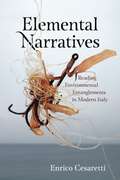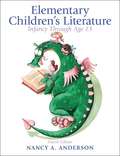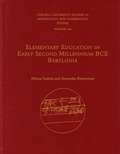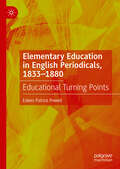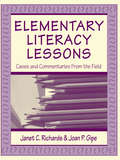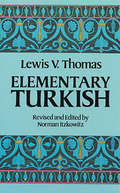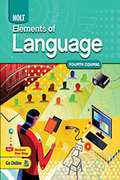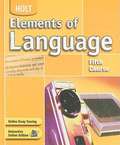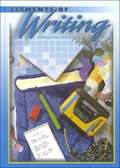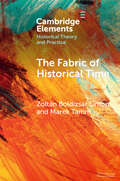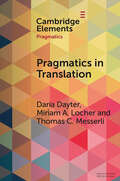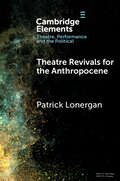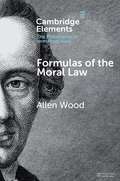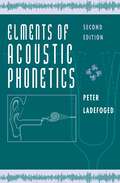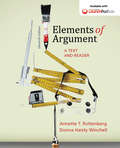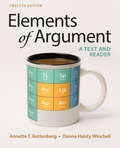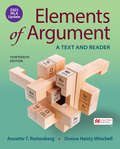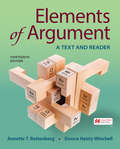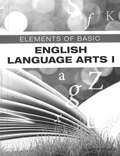- Table View
- List View
Elemental Narratives: Reading Environmental Entanglements in Modern Italy (AnthropoScene)
by Enrico CesarettiOver the past century, the Italian landscape has undergone exceedingly rapid transformations, shifting from a mostly rural environment to a decidedly modern world. This changing landscape is endowed with a narrative agency that transforms how we understand our surroundings. Situated at the juncture of Italian studies and ecocriticism and following the recent “material turn” in the environmental humanities, Elemental Narratives outlines an original cultural and environmental map of the bel paese. Giving equal weight to readings of fiction, nonfiction, works of visual art, and physical sites, Enrico Cesaretti investigates the interconnected stories emerging from both human creativity and the expressive eloquence of “glocal” materials, such as sulfur, petroleum, marble, steel, and asbestos, that have helped make and, simultaneously, “un-make” today’s Italy, affecting its socio-environmental health in multiple ways. Embracing the idea of a decentralized agency that is shared among human and nonhuman entities, Cesaretti suggests that engaging with these entangled discursive and material texts is a sound and revealing ecocritical practice that promises to generate new knowledge and more participatory, affective responses to environmental issues, both in Italy and elsewhere. Ultimately, he argues that complementing quantitative, data-based information with insights from fiction and nonfiction, the arts, and other humanistic disciplines is both desirable and crucial if we want to modify perceptions and attitudes, increase our awareness and understanding, and, in turn, develop more sustainable worldviews in the era of the Anthropocene. Elegantly written and convincingly argued, this book will appeal broadly to scholars and students working in the fields of environmental studies, comparative literatures, ecocriticism, environmental history, and Italian studies.
Elemental Narratives: Reading Environmental Entanglements in Modern Italy (AnthropoScene: The SLSA Book Series #6)
by Enrico CesarettiOver the past century, the Italian landscape has undergone exceedingly rapid transformations, shifting from a mostly rural environment to a decidedly modern world. This changing landscape is endowed with a narrative agency that transforms how we understand our surroundings. Situated at the juncture of Italian studies and ecocriticism and following the recent "material turn" in the environmental humanities, Elemental Narratives outlines an original cultural and environmental map of the bel paese. Giving equal weight to readings of fiction, nonfiction, works of visual art, and physical sites, Enrico Cesaretti investigates the interconnected stories emerging from both human creativity and the expressive eloquence of "glocal" materials, such as sulfur, petroleum, marble, steel, and asbestos, that have helped make and, simultaneously, "un-make" today’s Italy, affecting its socio-environmental health in multiple ways. Embracing the idea of a decentralized agency that is shared among human and nonhuman entities, Cesaretti suggests that engaging with these entangled discursive and material texts is a sound and revealing ecocritical practice that promises to generate new knowledge and more participatory, affective responses to environmental issues, both in Italy and elsewhere. Ultimately, he argues that complementing quantitative, data-based information with insights from fiction and nonfiction, the arts, and other humanistic disciplines is both desirable and crucial if we want to modify perceptions and attitudes, increase our awareness and understanding, and, in turn, develop more sustainable worldviews in the era of the Anthropocene. Elegantly written and convincingly argued, this book will appeal broadly to scholars and students working in the fields of environmental studies, comparative literatures, ecocriticism, environmental history, and Italian studies.
Elementary Children's Literature: Infancy Through Age 13
by Nancy A. AndersonThis widely popular book is organized around genres, including a complete chapter on each major genre plus a full chapter for each of the four subgenres of fiction. The teaching strategies, technology applications, coverage of culturally diverse literature, and instructional tie-ins are of immediate use to teachers and parents. Included in each genre chapter are bibliographies of exemplary books in print, multiple annotations, and evaluation criteria for the genre. The author writes in a conversational tone and defines each literary and educational term in the text the first time it is used, and then reinforces the meaning in a useful end-of-book glossary. <P><P> The extensive coverage of culturally diverse literature found throughout the book is supplemented by an excellent chapter (8) on culturally diverse literature written by minority literature specialists who give readers an insider's view of their cultures and provide annotated lists of books by (not just about) minority authors and illustrators. This, coupled with the many instructional ideas woven throughout the book, and the final chapter, "Teaching Reading through Literature," helps teachers and parents apply their knowledge of literature to help children grow in their language and reading abilities.
Elementary Education in Early Second Millennium BCE Babylonia (CUSAS)
by Alhena Gadotti Alexandra KleinermanIn this volume, Alhena Gadotti and Alexandra Kleinerman investigate how Akkadian speakers learned Sumerian during the Old Babylonian period in areas outside major cities. Despite the fact that it was a dead language at the time, Sumerian was considered a crucial part of scribal training due to its cultural importance. This book provides transliterations and translations of 715 cuneiform scribal school exercise texts from the Jonathan and Jeanette Rosen Ancient Near Eastern Studies Collection at Cornell University. These tablets, consisting mainly of lexical texts, illustrate the process of elementary foreign-language training at scribal schools during the Old Babylonian period. Although the tablets are all without provenance, discrepancies between these texts and those from other sites, such as Nippur and Ur, strongly suggest that the texts published here do not come from a previously studied location. Comparing these tablets with previously published documents, Gadotti and Kleinerman argue that elementary education in Mesopotamia was relatively standardized and that knowledge of cuneiform writing was more widespread than previously assumed.By refining our understanding of education in southern Mesopotamia, this volume elucidates more fully the pedagogical underpinnings of the world’s first curriculum devised to teach a dead language. As a text edition, it will make these important documents accessible to Assyriologists and Sumerologists for future study.
Elementary Education in Early Second Millennium BCE Babylonia (CUSAS: Cornell University Studies in Assyriology and Sumerology #42)
by Alhena Gadotti Alexandra KleinermanIn this volume, Alhena Gadotti and Alexandra Kleinerman investigate how Akkadian speakers learned Sumerian during the Old Babylonian period in areas outside major cities. Despite the fact that it was a dead language at the time, Sumerian was considered a crucial part of scribal training due to its cultural importance. This book provides transliterations and translations of 715 cuneiform scribal school exercise texts from the Jonathan and Jeanette Rosen Ancient Near Eastern Studies Collection at Cornell University. These tablets, consisting mainly of lexical texts, illustrate the process of elementary foreign-language training at scribal schools during the Old Babylonian period. Although the tablets are all without provenance, discrepancies between these texts and those from other sites, such as Nippur and Ur, strongly suggest that the texts published here do not come from a previously studied location. Comparing these tablets with previously published documents, Gadotti and Kleinerman argue that elementary education in Mesopotamia was relatively standardized and that knowledge of cuneiform writing was more widespread than previously assumed.By refining our understanding of education in southern Mesopotamia, this volume elucidates more fully the pedagogical underpinnings of the world’s first curriculum devised to teach a dead language. As a text edition, it will make these important documents accessible to Assyriologists and Sumerologists for future study.
Elementary Education in English Periodicals, 1833-1880: Educational Turning Points
by Edwin Patrick PowellThe nature and purpose of elementary education featured prominently in English periodicals throughout the nineteenth century. This book’s central argument is that the periodical press provided a unique cultural space for literary and intellectual contributions to sustained debates about education. Furthermore, political, economic, social, religious, literary, and cultural developments converged with pivotal educational turning points featured in periodicals that affirmed the creative force of education. However, relatively little scholarly attention has been given to periodicals as a medium for exploring the tension between competing educational ideas and practices in Victorian England. This book therefore reassesses elementary education through the new literary perspectives of periodical culture.
Elementary Literacy Lessons: Cases and Commentaries From the Field
by Janet C. Richards Joan P. GipeInnovative and practical, this text helps prepare teachers to support the literacy learning needs of all children in grades K-6, including academically, linguistically, and culturally diverse students. It features original teaching cases written by preservice teachers enrolled in field-based reading/language arts methods courses, accompanied by commentaries written by experienced teacher educators and skilled classroom teachers. High-interest content and a reader-friendly format encourage critical and reflective thinking about topics important to effective literacy instruction. By promoting reflection about case issues, the text helps prepare future teachers to respond to teaching narratives presented on the practical applications section of the PRAXIS II, an examination required in most states for teacher licensure. The authentic cases candidly and poignantly describe preservice teachers' plans, problems, hopes, disappointments, dilemmas, and reflective thinking as they address the multilayered complexities and ambiguities associated with learning to teach reading and language arts in elementary classrooms. These teaching stories reveal glimpses of literacy instruction and allow us to enter real classrooms and experience the wide varieties of situations that reading/language arts teachers encounter daily. Although the cases are grouped according to specific dimensions of literacy theory and pedagogy, just as in real classrooms, other issues are woven through each case as well. The commentaries provide scholarly, and sometimes contrasting, perspectives and approaches through which readers might consider the issues presented in the cases. The commentaries represent only particular perspectives, but readers are encouraged to explore and consider as many perspectives and issues as possible regarding each case. Each chapter includes helpfulpedagogical features: * New or critical concepts and terms listed at the beginning of each chapter alert readers to what might be unfamiliar vocabulary. * Applications and Reflections pages help readers take an active part in analyzing, documenting, and talking about the particular issues portrayed in the case narratives. Using the questions on these pages, the cases and accompanying commentaries can be read and discussed as a whole class activity, in small collaborative groups, or by individuals. The questions can also be used by readers to guide their own case writing initiatives. * Margin References direct readers to correlated readings for the strategies and parallel concepts mentioned in the cases and commentaries. Suggested readings can be discussed within the format of literacy study groups. * Annotated Bibliographies at the end of each chapter help readers construct more in-depth knowledge for the instructional strategies and activities discussed in the teaching cases. The cases, commentaries, and pedagogical features in this distinctive text provide rich opportunities for readers to discover what they need to know and how they need to think in order to teach reading and language arts effectively and successfully.
Elementary Syntactic Structures
by Cedric BoeckxMost syntacticians, no matter their theoretical persuasion, agree that features (types or categories) are the most important units of analysis. Within Chomskyan generative grammar, the importance of features has grown steadily and within minimalism, it can be said that everything depends on features. They are obstacles in any interdisciplinary investigation concerning the nature of language and it is hard to imagine a syntactic description that does not explore them. For the first time, this book turns grammar upside down and proposes a new model of syntax that is better suited for interdisciplinary interactions, and shows how syntax can proceed free of lexical influence. The empirical domain examined is vast, and all the fundamental units and properties of syntax (categories, parameters, Last Resort, labelling, and hierarchies) are rethought. Opening up new avenues of investigation, this book will be invaluable to researchers and students in syntactic theory, and linguistics more broadly.
Elementary Turkish (Dover Language Guides)
by Lewis ThomasTurkish is the primary language of some thirty million people. Anyone concerned with current social, political, and cultural developments in Turkey knows that a practical understanding of the basic patterns of modern Turkish is an invaluable skill that until now has been difficult to attain without extensive training.This superb grammar and exercise text, used successfully for years in Princeton University, enables English-speaking students — in and out of the classroom — to gain a quick and thorough understanding of modern Turkish. In a carefully arranged sequence of 23 lessons, Lewis V. Thomas, late Professor of Oriental Studies at Princeton, presents thorough coverage that allows the student to begin to use the basic patterns of modern Turkish without time-consuming and expensive private instruction.The method of instruction was devised after an extensive analysis of results in Princeton classrooms, and relies on exercises at the end of each lesson to test the student's grasp of the material. Beginning with the alphabet and numbers, Professor Thomas offers clear, concise coverage of articles, adjectives and nouns, common infinitives, personal pronouns, and elementary verbs. As the student's comprehension of basic elements develops, further lessons deal with more complicated subjects such as the possessive construction, past general verbs, postpositions, the partitive, progressive verb forms, and abbreviating verb forms. A complete Turkish-English glossary translates new vocabulary occurring in the exercises.Norman Itzkowitz, Professor of Near Eastern Studies at Princeton University, has skillfully made the necessary revisions and additions to complete Professor Thomas' work. For anyone who needs to communicate in this important and influential language, Professor Thomas' proven course, now in an inexpensive paperback edition, is the most effective method available.
Elements Of Language 2004: Grammar (Elements Of Language Ser.)
by O'Dell<P>Elements of Language Fifth Course<P> <P>Grammar, Usage, and Mechanics Instructional Framework by John E. Warriner
Elements Of Language: Grammar, Usage and Mechanics - Language Skills Practice for Chapters 10-26
by Holt Rinehart Winston StaffMost of the worksheets you will find in this workbook are traditional worksheets providing practice and reinforcement activities on every rule and on all major instructional topics in the grammar, usage, and mechanics chapters in Elements of Language.
Elements Of Literature Fourth Course
by Holt Rinehart WinstonThe authors of this have established the literary framework of the Elements of Literature program and developed instructional materials for the elements of drama, poetry, and fiction in the book.
Elements Of Literature Second Course
by Robert Anderson John Malcolm Brinnin John Leggett David Adams LeemingElements Of Literature Second Course is specially designed to accommodate all students to learn literature, enabling them to acquire a skill at a time. It gives teachers an exciting way to teach in the classrooms as it also provides a teachers manual for every course titles. The English Department could not have a better book that masters, captures and informs on the elements of literature.
Elements Of Writing: First Course
by KinneavyHolt Elements of Writing Student Edition Grade 7 9780030508622
Elements in Historical Theory and Practice: The Fabric of Historical Time (Elements In Historical Theory And Practice Ser.)
by Marek Tamm Zoltán Boldizsár SimonElements in Pragmatics: Mediality, Participation And Relational Work (Elements In Pragmatics Ser.)
by Daria Dayter Thomas C. Messerli Miriam A. LocherElements in Theatre, Performance and the Political: Theatre Revivals for the Anthropocene (Elements In Theatre, Performance And The Political Ser.)
by Patrick LonerganElements in the Philosophy of Immanuel Kant: Formulas of the Moral Law (Elements In The Philosophy Of Immanuel Kant Series)
by Allen WoodThis Element defends a reading of Kant's formulas of the moral law in Groundwork of the Metaphysics of Morals. It disputes a long tradition concerning what the first formula (Universal Law/Law of Nature) attempts to do. <P><P>The Element also expounds the Formulas of Humanity, Autonomy and the Realm of Ends, arguing that it is only the Formula of Humanity from which Kant derives general duties, and that it is only the third formula (Autonomy/Realm of Ends) that represents a complete and definitive statement of the moral principle as Kant derives it in the Groundwork. The Element also disputes the claim that the various formulas are 'equivalent', arguing that this claim is either false or else nonsensical because it is grounded on a false premise about what Kant thinks a moral principle is for.
Elements of Acoustic Phonetics
by Peter LadefogedThis revised and expanded edition of a classic textbook provides a concise introduction to basic concepts of acoustics and digital speech processing that are important to linguists, phoneticians, and speech scientists. The second edition includes four new chapters that cover new experimental techniques in acoustic phonetics made possible by the use of computers. Assuming no background in physics or mathematics, Ladefoged explains concepts that must be understood in using modern laboratory techniques for acoustic analysis, including resonances of the vocal tract and the relation of formants to different cavities; digital speech processing and computer storage of sound waves; and Fourier analysis and Linear Predictive Coding, the equations used most frequently in the analysis of speech sounds. Incorporating recent developments in our knowledge of the nature of speech, Ladefoged also updates the original edition's discussion of the basic properties of sound waves; variations in loudness, pitch, and quality of speech sounds; wave analysis; and the hearing and production of speech. Like its predecessor, this edition of Elements of Acoustic Phonetics will serve as an invaluable textbook and reference for students and practitioners of linguistics and speech science, and for anyone who wants to understand the physics of speech.
Elements of Argument
by Annette T. Rottenberg Donna Haisty WinchellPACKAGE THIS TITLE WITH OUR 2016 MLA SUPPLEMENT, Documenting Sources in MLA Style (package ISBN-13: 9781319084639). Get the most recent updates on MLA citation in a convenient, 40-page resource based on The MLA Handbook, 8th Edition, with plenty of models. Browse our catalog or contact your representative for a full listing of updated titles and packages, or to request a custom ISBN. Elements of Argument combines a thorough argument text on critical thinking, reading, writing, and research with an extensive reader on both current and timeless controversial issues. It presents everything students need to analyze, research, and write arguments. Elements of Argument covers Toulmin, Aristotelian, and Rogerian models of argument and has been thoroughly updated with current selections students will want to read. With three-quarters of the readings new to this edition (and with additional multimodal selections available online), expanded coverage of key rhetorical issues, reorganized research chapters, and a fresh design, Elements of Argument is a truly flexible classroom resource. An e-book is available at half the price of the print book. Our newest set of online materials, LaunchPad Solo, provides all the key tools and course-specific content that you need to teach your class. Get all our great course-specific materials in one fully customizable space online; then assign and mix our resources with yours. To package LaunchPad Solo free with Elements of Argument, Eleventh Edition, use 978-1-319-01079-9.
Elements of Argument
by Annette T. Rottenberg Donna Haisty WinchellElements of Argument teaches students how to approach, develop, and defend arguments one element at a time. This comprehensive, accessible text carefully scaffolds argument for students, explaining approaches to argumentation, (including Aristotelian, Toulmin, and Rogerian models as well as Stasis Theory questions), critical reading, and argument analysis. The major components of argumentation--claims, support, assumptions, logic--are explained in depth, and a robust research section shows students how to find, incorporate, and build on existing arguments. This Twelfth Edition has also been updated with more sourced readings than ever before, further reinforcing the importance of research and synthesis. Finally, the anthology includes debates and casebooks on unsettled current issues as well as timeless, classic arguments, making Elements of Argument a comprehensive resource for the argument classroom.
Elements of Argument with 2021 MLA Update: A Text and Reader
by Annette T. Rottenberg Donna Haisty WinchellThis ebook has been updated to provide you with the latest guidance on documenting sources in MLA style and follows the guidelines set forth in the MLA Handbook, 9th edition (April 2021).With Elements of Argument you get two books in one: an argument text and a reader focused on the issues you care about. In addition you’ll find lots of support to help you understand the components of argument in order to build your own compelling essays. And if you’re writing a research paper, you’ll appreciate the guidance on evaluating sources for bias and the sample essays that model effective use of digital sources.
Elements of Argument: A Text and Reader
by Annette T. Rottenberg Donna Haisty WinchellWith Elements of Argument you get two books in one: an argument text and a reader focused on the issues you care about. In addition you�ll find lots of support to help you understand the components of argument in order to build your own compelling essays. And if you�re writing a research paper, you�ll appreciate the guidance on evaluating sources for bias and the sample essays that model effective use of digital sources.
Elements of Basic: English Language Arts I
by Nancy NicholsElements Of Basic English Language Arts I
